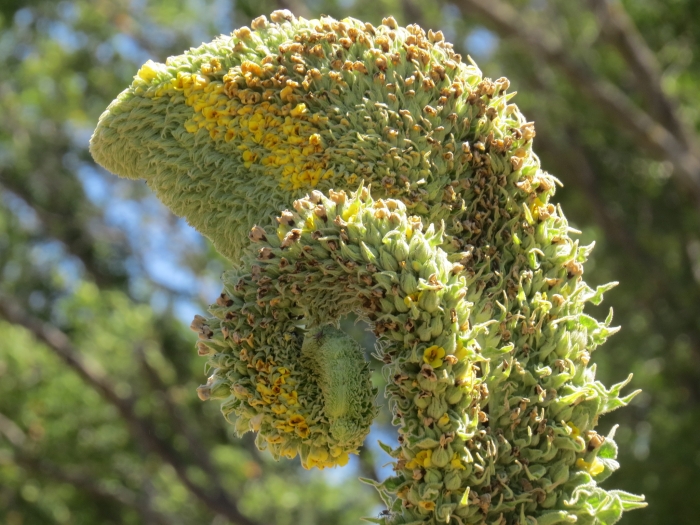Common Mullein
(Verbascum thapsus)
Common Mullein (Verbascum thapsus)
/
/

Garth Harwood
CC BY 4.0
Image By:
Garth Harwood
Recorded By:
Copyright:
CC BY 4.0
Copyright Notice:
Photo by: Garth Harwood | License Type: CC BY 4.0 | License URL: http://creativecommons.org/licenses/by/4.0/ | Rights Holder: Garth Harwood | Publisher: iNaturalist | Date Created: 2023-08-03T11:19:21-07:00 |











Estimated Native Range
Summary
Verbascum thapsus, commonly known as common mullein, is a biennial herb that is native to Europe, North Africa, and Asia, and has widely naturalized in the Americas and Australia. It typically grows in a rosette of large, velvety leaves in the first year and sends up a tall flowering stalk in the second year, reaching heights of 5 to 6 feet (1.5 to 1.8 meters). The plant is characterized by its erect, rod-like stem with dense, yellow flower spikes that bloom from June to September. The flowers are not particularly showy, but they are attractive to a variety of pollinators. Common mullein is often found in disturbed soils such as fields, roadsides, and waste areas.
Common mullein is valued for its ease of growth and its traditional use in herbal medicine, where it has been used to treat respiratory ailments. It is also used ornamentally for its striking foliage and architectural height in garden borders and wildflower meadows. This plant prefers full sun and can tolerate a range of soil conditions, from sandy to loamy, with good drainage. It is drought-tolerant once established and requires minimal maintenance. However, gardeners should be aware that it can self-seed prolifically and may become weedy or invasive in some regions.CC BY-SA 4.0
Common mullein is valued for its ease of growth and its traditional use in herbal medicine, where it has been used to treat respiratory ailments. It is also used ornamentally for its striking foliage and architectural height in garden borders and wildflower meadows. This plant prefers full sun and can tolerate a range of soil conditions, from sandy to loamy, with good drainage. It is drought-tolerant once established and requires minimal maintenance. However, gardeners should be aware that it can self-seed prolifically and may become weedy or invasive in some regions.CC BY-SA 4.0
Plant Description
- Plant Type: Herb
- Height: 3-10 feet
- Width: 2-3 feet
- Growth Rate: Rapid
- Flower Color: Yellow
- Flowering Season: Summer, Fall
- Leaf Retention: Semi-deciduous
Growth Requirements
- Sun: Full Sun
- Water: Low
- Drainage: Fast, Medium, Slow
Common Uses
Drought Tolerant, Low Maintenance
Natural Habitat
Europe, North Africa, and Asia, and has widely naturalized in disturbed soils such as fields, roadsides, and waste areas in the Americas and Australia
Other Names
Common Names: Common Mullein, Big Taper, Blanketweed, Flannel Mullein, Great Mullein
Scientific Names: , Verbascum thapsus, Thapsus barbatus, Verbascum bicolle, Verbascum blattaria, Verbascum indicum, Verbascum linnaei, Verbascum phlomoides, Verbascum simplex var. dyris, Verbascum subviride
GBIF Accepted Name: